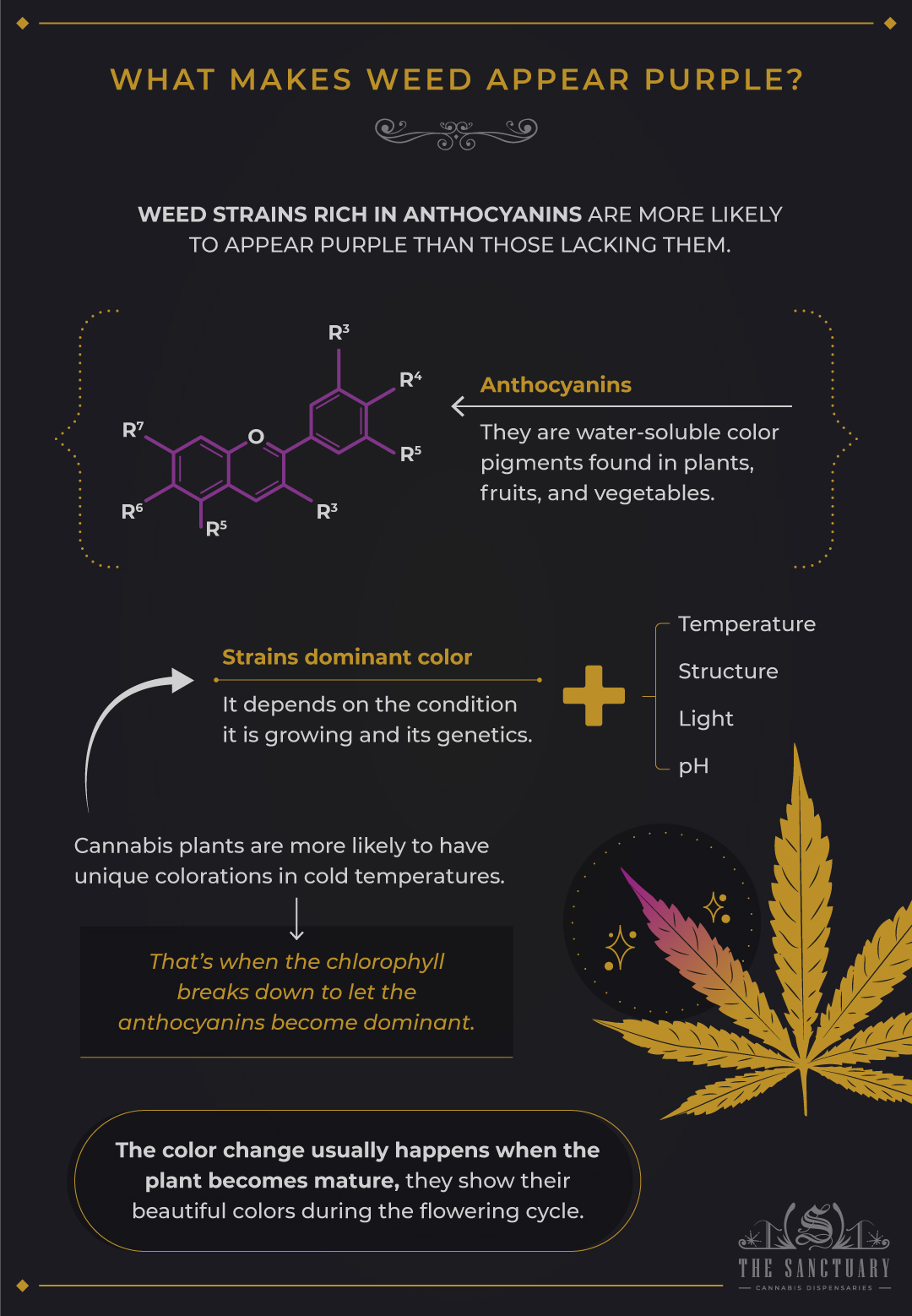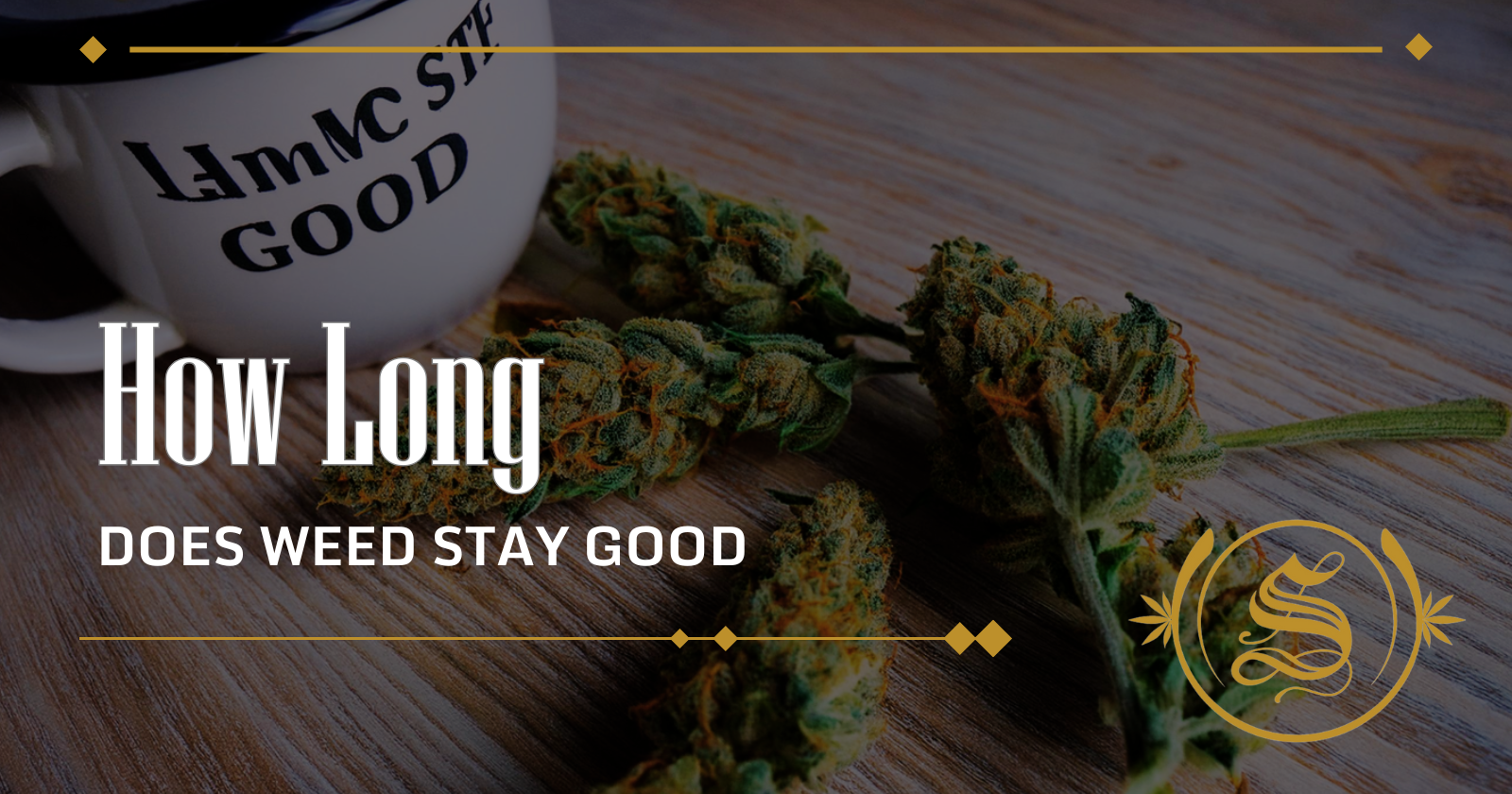Iftikhar Alam
Author
Reviewed by Cannabis Experts
Published on: October 9, 2023 | Updated on: September 11, 2024
Smoking standard weed is fun and cool, but it can get boring at some point. If you want to jazz up your weed sessions, try including a striking purple-colored weed strain in your stash. Not only do these strains look beautiful, but they also offer a stronger, mind-altering smoking experience.
Contrary to the popular misconception, color has nothing to do with a strain’s potency. Weed usually appears purple due to a water-soluble pigment called anthocyanin. In fact, it is also found in many fruits and vegetables, responsible for the red, blue, and black colorations.
Weed is likely to turn purple in winter. This is the time when chlorophyll breaks down, giving room to anthocyanins to give off different hues to the plant. Let’s learn more about purple weed and see how many purple strains you can get your hands on.
What Makes Weed Appear Purple?

Weed strains rich in anthocyanins are more likely to appear purple than those lacking them. Anthocyanins are water-soluble color pigments found in plants, fruits, and vegetables. They are the reason for the blue color of blueberries, the black of blackberries, and the red of red grapes.
Anthocyanins naturally occur in cannabis plants, making their buds appear red, golden, dark green, black, purple, blue, and more.
The dominant color in each strain depends on the condition it is growing and its genetics. Some factors affecting the cannabis plant’s color and anthocyanin’s stability are temperature, structure, light, and pH.
Just like plants change color with the seasons, cannabis leaves may also have different colors. They are more likely to have unique colorations in cold temperatures, particularly around fall and winter. That’s when the chlorophyll breaks down to let the anthocyanins become dominant.
The color change usually happens when the plant becomes mature. Those cannabis plants with a high anthocyanin content show their beautiful colors during the flowering cycle.
Anthocyanins: What Are They Actually?
Anthocyanins are members of the flavonoid group, which are phytochemicals occurring naturally in cereals, fruits, vegetables, nuts, and teas. Flavonoids are also present in cannabis plants, along with terpenes and cannabinoids.
Besides giving color to plants, anthocyanins also have many health benefits. These pigments are believed to possess antimicrobial and antioxidative properties that help protect against multiple diseases and improve mental and visual health.
Flavonoids and anthocyanins also have anti-inflammatory effects. A 2010 study found that anthocyanins can play a crucial part in improving cardiac, liver, and vision health. Not only that, but they can also prevent many diseases, such as diabetes and obesity.
Plants rich in anthocyanin have been used in herbal medicine for many years in China, North America, and Europe. This raises the question: “Is purple weed more beneficial than the regular green strains?” No, because the color has nothing to do with a weed strain’s potency.
When you consume a weed strain, its anthocyanins are already absorbed in your digestive tract. So, to observe any difference from the strain, you’d have to eat bundles of purple weed. Not a good idea, right?
The Best Purple Weed Strains
Surprisingly, purple weed is more common than you think. When searching for a purple-hued strain, you may come across various options, making it hard to choose one.
For your ease, we have listed down some most popular purple weed strains that you should try:
- Purple Haze
- Mendocino Purps
- Sour Grape
- Grape Ape
- Granddaddy Purple (GDP)
- Purple Urkle
- Obama Kush
- Purple Diesel
- Purple Berry
- Blackwater
- Purple #1
- Lavender (and Lavender Jones)
- Purple Kush
- Purple Afghani
- Candyland
- Purple Skunk
- Purple Punch
- Hawaiian Purple
Many other cannabis strains can also become purple in colder environments, but the above varieties are more likely to display purple hues.
How to Grow Purple Weed at Home
Growing a cannabis plant requires a lot of effort and care. One mistake can ruin your months of hard work. So, it’s essential to know how to grow purple weed the right way.
Here are some things you must keep in mind when growing purple weed at home:
Choose the Right Strain
Genetics and environmental factors play a major role in making weed appear purple. Some strains easily turn purple, but others take significant time to transform. In fact, a few strains stay green regardless of your efforts.
Thus, you must choose a strain rich in anthocyanins to grow purple weed properly. Start with finding the one that has “purple” in the name, or simply select a strain from the above list.
Expose the Plant to a Cold Temperature
Cold temperature sets the right environment for weeds to turn purple. It breaks the chlorophyll, the green pigment in plants, to let anthocyanins become the dominant color pigment. As a result, the plant gives off a distinctive purple hue.
So, you should expose your cannabis growth to cold temperatures to accelerate this process. However, you should be careful, as extreme cold can damage the plant and lead to its death.
The best way to establish the ideal cold environment for your cannabis plant is by decreasing the temperature when its harvest time is near, particularly during the dark cycle. You should set the nighttime temperature to about 50°F/10°C. But don’t forget to reduce it gradually to protect your plant from getting into a shock.
Exposing cannabis to colder temperatures should be done before harvesting. That’s because too much cold can decrease its yield. So, keep an eye on your cannabis plant throughout the process to detect anything wrong.
Note: This technique will only work for the cannabis strain that’s genetically programmed to turn purple.
Check pH Levels
Anthocyanins give off various colors to plants at different pH levels. They appear red in low pH or acidic conditions and blue in high pH or alkaline conditions. In neutral pH conditions, the anthocyanins usually appear purplish.
It shows that the pH of the growing conditions affects how your plant will turn out. So, maintain the correct pH levels for your strain to achieve a beautiful purple hue for your cannabis growth.
Conclusion
Purple weed isn’t just about the exotic appearance; it’s also considered a more potent and efficient strain of cannabis. Some weed strains are naturally purple due to the presence of anthocyanins, while others can turn purple due to various reasons.
Your weed may turn purple when grown at the ideal pH level. The temperature must be cold, ideally 50°F/10°C for the night time. However, not all weed strains can turn purple. Thus, the color change will only appear in those strains that are genetically capable of doing so.
The content provided on this blog is for informational purposes only and does not constitute medical, legal, or professional advice. Cannabis use is subject to local laws and regulations, which vary widely by jurisdiction. Always consult with a healthcare professional before starting any new treatment or altering an existing treatment regimen. The authors and publishers of this blog are not responsible for any actions taken based on the information provided herein. Use cannabis responsibly and in accordance with applicable laws. This blog is intended for adults aged 21 and over. The Sanctuary Dispensaries D186, D187.








